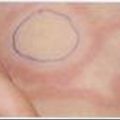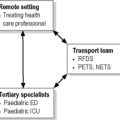3.4 Abdominal and pelvic trauma
Introduction
Well over 90% of abdominal injuries in children are the result of blunt trauma. While penetrating injuries are increasing in incidence in the adolescent population, this remains an unusual phenomenon in most Australasian communities. Abdominal injuries resulting from blunt trauma commonly affect the solid organs, particularly the liver and spleen. Overall mortality is generally <5%, but obviously this depends on injury mechanism.1 In children with multitrauma, the subtle early clinical findings of intra-abdominal injury may be masked by change in conscious state, and chest and limb injuries, and require repeated abdominal examination.
There are unique characteristics of children that predispose them to intra-abdominal injuries. The rib cage does not extend as far distally as in the adult, the ribs are more compliant, and the abdominal wall and musculature frequently thinner and less protective. The organs are closely packed together and there is less ‘padding’ soft tissue to absorb the kinetic energy transmitted by the impact.2 The upper abdominal viscera are more at risk of injury, and relatively minor forces can be transmitted, resulting in a serious disrupting injury.3
The bladder is not as well protected by the bony pelvis as in the adult, increasing the risk of bladder injury in lower abdominal trauma. Gaseous distension of the stomach from air swallowing during crying or bag–valve–mask ventilation occurs rapidly and can impair ventilation. Likewise, acute gastric dilatation or a large bladder can seriously impede clinical assessment of the abdomen. The very compliant body of the child is capable of absorbing considerable amounts of kinetic energy without external signs, yet be associated with significant internal derangement.3 Children are generally healthy, with few comorbidities and on few, if any, medications. In physiological terms, they are therefore able to compensate extremely well for blood loss.2
History
Small children are particularly at risk of being unsighted and backed over in driveways by reversing vehicles, and may sustain major internal injuries. The recognition of abuse as a causal mechanism in younger children and infants is important in patients with abdominal trauma. There may be minimal signs of external injury, and the reported history may suggest a minor incompatible mechanism or no history of injury at all. The emergency physician needs to maintain an index of suspicion in the infant who presents in shock or with an altered level of consciousness (see Chapter 3.2).
Other information, such as medications, allergies, and significant past history, should be obtained.
Investigations
Laboratory
Blood should be taken for group and hold, full blood examination (FBE), liver function tests, amylase, and blood glucose. Urine should be obtained for examination. Some studies have demonstrated that elevated transaminases in combination with an abnormal physical examination are associated with intra-abdominal injury (although not a specific organ injury).4,5 However, at present there are no laboratory studies that can be recommended as a screening tool for intra-abdominal injury.
In the context of pancreatic injury, serum amylase often rises, but the initial amylase may be normal, with increasing values over 3 days.6
Focused assessment by sonography for trauma (FAST)
Ultrasound has been promoted as a quick and effective initial screening tool in the evaluation of the abdomen in the traumatised child.7–10 Ultrasound in this setting is aimed at the detection of free fluid in the peritoneal cavity. No attempt is made during this rapid assessment to identify solid visceral injury. This examination takes between 3 and 5 minutes, and can be achieved at the bedside in the resuscitation area. While there is much supportive literature for this modality,7–9 there is also some cautionary research.10 Detractors cite concerns of low sensitivities in the detection of free fluid; however, several studies have documented sensitivities from 89 to 100%. Providing the limitations of FAST are appreciated, it remains an invaluable tool, particularly in the assessment of the multiply injured child. Identification of free fluid in the stable child with normal vital signs should be followed by CT examination. The detection of free fluid in the child with deteriorating vital signs supports the decision for operative treatment. FAST ultrasound is operator-dependent and should be performed only by clinicians with appropriate training and credentialing.
CT scan
This is the investigation of choice in stable children with abdominal trauma in consultation with a paediatric surgeon. With the evolution and common acceptance of non-operative management of blunt abdominal injuries, diagnostic imaging is an essential component of the assessment process of the injured child. CT has emerged as the gold standard.11 It identifies free intra-abdominal fluid, solid visceral injury and the injury configuration, and loops of bowel, and demonstrates free peritoneal gas. The retroperitoneum is well visualised. CT examination should be performed after the administration of intravenous contrast. This enables better visualisation, although in situations of renal hypoperfusion renal failure can be precipitated, and allergy to the contrast is a rare but potentially serious problem. The addition of oral contrast may increase diagnostic accuracy in detecting duodenal or pancreatic injury but this is controversial and institutional practice may vary.
CT scanning carries a radiation risk to the child. This needs to be considered when ordering such an investigation. CT scanning should be reserved for those patients in whom there is a high index of suspicion of intra-abdominal injury. Literature is now emerging that addresses the use of CT scanning in children.12
Surgical issues
Selective non-operative management of solid visceral injury in children is now well established. It is clear that bleeding from an injured spleen, liver, or kidney is generally self-limiting.11 Success rates in excess of 90% with non-operative care mean that operative management is an exceptional event at many institutions. Pancreatic injuries, however, usually result in a higher incidence of operative intervention. Operative management is the rule for hollow viscus injuries. Some injuries, such as duodenal haematoma without evidence of perforation, may be managed without surgery. The decision about operative versus non- operative management is made by the surgeon who will have ongoing care of the child. This decision is strongly influenced by clear details regarding progression of vital signs, response to fluid therapy, and associated injuries. A non-operative approach must take place only in an institution with an available surgeon with a commitment to the injured child and dedicated paediatric intensive care or high-dependency facility.13 This may necessitate the transfer of the child to a regional centre.
Pelvic fractures
A child who sustains a fractured pelvis has been exposed to severe trauma. These are uncommon injuries in children, occurring at half the frequency as in adults.14 There are several major differences in the bony pelvis between the child and adolescent or the adult. There is greater elasticity in the sacroiliac joints and pubic symphysis, and plasticity of the bone, in the paediatric pelvis, therefore greater amounts of kinetic energy must be involved to cause fracture. Avulsion fractures occur in children and adolescents because cartilage is weaker than bone. This occurs at the physis. Greater laxity of the joints in the paediatric pelvis means that single fractures occur more commonly, as opposed to the adult pelvis, where there is the double-break concept. Fractures occurring through epiphyseal and apophyseal growth centres may result in growth arrest, leg length discrepancy, and deformity. Children also have increased capacity for remodelling.15
The common mechanisms for pelvic fracture are motor vehicle accidents and motor vehicle-pedestrian collisions, followed by falls.15
There are several classification systems for pelvic fractures. None is ideal. Torode and Zeig described four groups of pelvic fracture but failed to include isolated acetabular fractures.16 This has been modified by Silber et al,15 whose classification by mechanism of injury and description is useful (Table 3.4.1).
Originally described by Torode and Zeig16 and modified by Silber et al.14
Bladder injury, while more common than in the adult, is an infrequent association. In a review of 166 children with pelvic fractures, there was one urethral disruption and two bladder contusions.15 There is a strong association of these injuries with straddle-type mechanism. Children commonly receive ‘fall astride’ injuries related to playground equipment or while riding bicycles.
In Silber’s series, 97% of children were treated non-operatively.15 The majority of these injuries (63%) were type 3 fractures. The remainder were type 2 (17%) and type 4 fractures (17%). In this series, six children died; all these deaths were due to associated injuries. The mortality rate from paediatric pelvic fractures is consistently less than 6% in recent studies.14 In a study comparing paediatric and adult fractures, the mortality rate for children was 5.7% compared with 17.5 % in the adult group. Vascular injury and exsanguination in children is rare, in contrast to in adults. This is thought to be due to the greater skeletal flexibility and the greater ability of paediatric arteries to constrict after injury.
Disposition
 The necessity to use double contrast for CT abdominal examinations. IV contrast is required, but the need for oral contrast is controversial.
The necessity to use double contrast for CT abdominal examinations. IV contrast is required, but the need for oral contrast is controversial. Defining the haemodynamically unstable child. When in doubt, discuss the child with an emergency or surgical colleague. Children can be profoundly hypovolaemic with normal vital signs or only tachycardia. Ongoing fluid requirements and indices of peripheral perfusion are important indicators of volaemic status.
Defining the haemodynamically unstable child. When in doubt, discuss the child with an emergency or surgical colleague. Children can be profoundly hypovolaemic with normal vital signs or only tachycardia. Ongoing fluid requirements and indices of peripheral perfusion are important indicators of volaemic status.1 Stafford P.W., Blinman T.A., Nance M.L. Practical points in evaluation and resuscitation of the injured child. Surg Clin North Am. 2002;82:273-301.
2 Gaines B.A. Intra-abdominal solid organ injury in children: diagnosis and treatment. J Trauma. 2009;67(2):S135-S139.
3 Tepas J.J. Paediatric trauma. In: Moore E.E., Mattox K.L., Feliciano D.V., editors. Trauma. 4th ed. New York: McGraw-Hill Education; 2003:1075-1098.
4 Holmes J.F., Sokelove P.E., Brant W.E. Identification of children with intra-abdominal injuries after blunt trauma. Ann Emerg Med. 2002;39:500-509.
5 Cotton B.A., Liao J.G., Burd R.S. The utility of clinical and laboratory data for detecting intraabdominal injury among children. J Trauma. 2004;56:1068-1074.
6 Sjovall A., Hirsh K. Blunt abdominal trauma in children: Risks of nonoperative treatment. J Pediatr Surg. 1997;32:1169-1174.
7 Akgur F.M., Aktug T., Olguner M., et al. Prospective study investigating routine usage of ultrasonography as the initial diagnostic modality for the evaluation of children sustaining blunt abdominal trauma. J Trauma. 1997;42:626-628.
8 Thourani V.H., Pettitt B.J., Schmidt J.A., et al. Validation of surgeon-performed emergency abdominal ultrasonography in pediatric trauma patients. J Pediatr Surg. 1998;33:322-328.
9 Corbett S.W., Andrews H.G., Baker E.M., et al. ED evaluation of the pediatric trauma patient by ultrasonography. Am J Emerg Med. 2000;18:244-249.
10 Coley B.D., Mutabagani K.H., Martin L.C., et al. Focused abdominal sonography for trauma (FAST) in children with blunt trauma. J Trauma. 2000;48:902-906.
11 Eppich W.J., Zonfrillo M.R. Emergency department evaluation and management of blunt abdominal trauma in children. Curr Opin Pediatr. 2007;19:265-269.
12 Rice H.E., Frush D.P., Farmer D., Waldhausen J.H. APSA Education Committee. Review of radiation risks from computed tomography: essentials for the pediatric surgeon. J Pediatr Surg. 2007;42:603-607.
13 Advanced Life Support Group. Advanced Paediatric Life Support Manual, 3rd ed. London: BMJ Books; 2001.
14 Ismail N., Bellemare J.F., Mollitt D.L., et al. Death from pelvic fracture: Children are different. J Pediatr Surg. 1996;31:82-85.
15 Silber J.S., Flynn J.M., Koffler K.M., et al. Analysis of the cause, classification and associated injuries of 166 consecutive pediatric pelvic fractures. J Pediatr Surg. 2001;21:446-450.
16 Torode I., Zeig D. Pelvic fractures in children. J Pediatr Surg. 1985;5:76-84.





